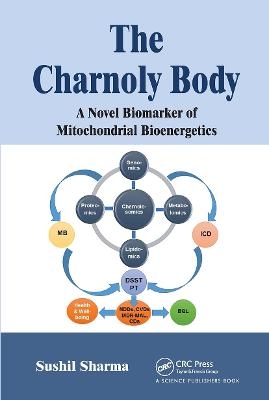
The Charnoly Body
CRC Press (Verlag)
978-0-367-78029-6 (ISBN)
Diversified physicochemical injuries trigger Charnoly body (CB) formation as pleomorphic, electron-dense, multi-lamellar stacks of nonfunctional mitochondrial membranes in the most vulnerable cell. Free radicals induce downregulation of mitochondrial DNA, microRNA, AgNOR, and epigenetics to trigger CB molecular pathogenesis. CB is eliminated by energy (ATP)-driven lysosome-dependent charnolophagy as a basic molecular mechanism of intracellular detoxification to prevent acute and chronic diseases. Accumulation of CB at the junction of axon hillock and charnolosome (CS) at the synapses causes cognitive impairments; whereas, nonspecific induction of CB causes GIT stress, myelosuppression, alopecia, neurotoxicity, cardiotoxicity, and infertility in multidrug-resistant malignancies. Hence, stem cell-specific CB, charnolophagy, and CS agonists/antagonists are introduced as novel charnolopharmacotherapeutics for the successful treatment of cardiovascular diseases, neurodegenerative diseases, infectious diseases, drug addiction, and cancer. Nanoparticles to improve drug delivery, CS exocytosis, and disease-specific spatiotemporal charnolosomics employing correlative and combinatorial bioinformatics boost mitochondrial bioenergetics through balanced diet, exercise, and antioxidants. The book will be of interest to medical scientists and practitioners.
Dr Sushil Sharma is a Professor and Course Director of Pharmacology at the Saint James School of Medicine in Saint Vincent & Grenadines. He received Ph.D. in Neuropharmacology from A.I.IM.S, New Delhi; Radiopharmaceutical Trainings from BARC, Bombay, GE, Siemens, Agilent Technologies, & Cardinal Health in the U.S. He has organized and chaired several world conferences, has been awarded 5 gold medals, a certificate of honor at I.T Nano-2014 Conference, Boston. (Original Discoveries: Electromicroinjector; Charnoly Body in Purkinje Neurons, IL-10 Receptors on Cortical Neurons, & MTs-Gene-Manipulated Mice), and authored 235 publications.
GENERAL INTRODUCTION OF CHARNOLY BODY AS A NOVEL THERANOSTIC BIOMARKER (Basic Cellular and Molecular Biology). Free Radical–Induced Compromised Mitochondrial Bioenergetics Triggers Charnoly Body Formation. Free Radical-Induced Molecular Pathophysiology of Charnoly body and Charnolosome. Charnoly Body as a Novel Biomarker of Cell Injury. Charnoly Body as a Novel Biomarker of Compromised Mitochondrial bioenergetics. Antioxidants Prevent Charnoly Body Formation, Augment Charolophagy, and Stabilize Charnolosome to Enhance Mitochondrial bioenergetics and Intracellular Detoxification. Metallothioneins Inhibit Charnoly Body Formation and Confer Structural and Functional Stability to Charnolosome. Clinical Significance of Charnoly Body as a Biomarker of Compromized Mitochodrial Bioenergetics in Multidrug-Resistant Diseases. CHARNOLY BODY AS A BIOMARKERS IN DRUG DISCOVERY EMERGING BIOTECHNOLOGY IN CHARNOLY BODY RESEARCH (Personalized Theranostics). Development of Novel Charnolopharmacotherapeutics in Pharmaceutical Industry by Flow Cytometric Analysis. Charnoly Body as a Novel Biomarker in Nanomedicine. Clinical Significance of Mitochondrial Bioenergetic and Charnoly Body in Evidence Based Personalized Nanotheranostics. Translational Multimodality Neuroimaging of Charnoly Body, Charnolophagy, and Charnolosome for Personalized theranostics of Chronic MDR Diseases. PET Radiopharmaceuticals and Surface Plasmon Resonance Spectroscopy for Charnoly Body and micro-RNA Based Personalized Theranostics. Theranostic Potential of Stem Cells from Different Biological Sources as Charnoly Body Anagonists, Charnolophagy Agonists, and Charnolosome Stabilizers. Charnolopharmacotherapeutics of Chronic Multidrug Resistant Diseases by Metallothionein-Induced Hypoxia Inducible Factor-1. CHARNOLY BODY MOLECULAR PATHOGENESIS CLINICAL SIGNIFICANCE OF DISEASE-SPECIFIC CHARNOLY BODY FORMATION AND OTHER BIOMARKERS IN CHRONIC DISEASES (Recent Update on Evidence-Based Personalized Theranostics). Disease-Specific Charnoly Body Formation. Charnoly Body in Fetal Alcohol Syndrome. Charnoly Body in Nicotinism. Charnoly Body in ZIKV Disease. Charnoly Body in Malnutrition (Mitochondrial Bioenergetics in Health and Disease). Charnoly Body Formation in Drug Addiction and other Chronic Multi-Drug-Resistant Diseases (Therapeutic Potential of MTs). Charnoly Body in Cardiovascular Disease. Charnoly Body in Stroke. Charnoly Body in Traumatic Brain Injury and PTSD. Charnolopharmacotherapy of Neurodegenerative and other Diseases.
| Erscheinungsdatum | 06.04.2021 |
|---|---|
| Verlagsort | London |
| Sprache | englisch |
| Maße | 156 x 234 mm |
| Gewicht | 1020 g |
| Themenwelt | Studium ► 2. Studienabschnitt (Klinik) ► Pharmakologie / Toxikologie |
| Naturwissenschaften ► Biologie ► Biochemie | |
| ISBN-10 | 0-367-78029-1 / 0367780291 |
| ISBN-13 | 978-0-367-78029-6 / 9780367780296 |
| Zustand | Neuware |
| Informationen gemäß Produktsicherheitsverordnung (GPSR) | |
| Haben Sie eine Frage zum Produkt? |
aus dem Bereich


